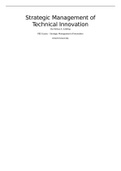Strategic Management of
Technical Innovation
By Melissa A. Schilling
FBE Course – Strategic Management of Innovation
Utrecht University
,Chapter 2 – Sources of innovation
Firms often collaborate with a number of external organizations (or individuals) in their innovation
activities. Firms are most likely to collaborate with customers, suppliers, and universities, though
they also may collaborate with competitors, producers of complements, government laboratories,
nonprofit organizations, and other research institutions.
Probably the most significant source of innovation does not come from individual organizations or
people, but from the collaborative networks that leverage resources and capabilities across multiple
organizations or individuals. Collaborative networks are particularly important in high-technology
sectors. Such collaborations include (but are not limited to) joint ventures, licensing and second-
sourcing agreements, research associations, government-sponsored joint research programs, value-
added networks for technical and scientific interchange, and informal networks.
Technology clusters Regional clusters of firms that have a connection to a common technology, and
may engage in buyer, supplier, and complementor relationships, as well as research collaboration.
Clusters often encompass an array of industries that are linked through relationships between
suppliers, buyers, and producers of complements. One primary reason for the emergence of regional
clusters is the benefit of proximity in knowledge exchange.
Technology spillovers are positive externality benefits of R&D, such as when the knowledge acquired
through R&D spreads to other organizations. Technological spillovers occur when the benefits from
the research activities of one firm (or nation or other entity) spill over to other firms (or nations or
other entities).
Chapter 3 – Types and patterns of innovation
Product innovations are embodied in the outputs of an organization—its goods or services, even if
those products are services. Process innovations are innovations in the way an organization conducts
its business, such as in the techniques of producing or marketing goods or services. Process
innovations are often oriented toward improving the effectiveness or efficiency of production by, for
example, reducing defect rates or increasing the quantity that may be produced in a given time.
A radical innovation is very new and different from prior solutions, whereas an incremental
innovation makes a relatively minor change from (or adjustment to) existing practices.
A competence-enhancing innovation builds on existing knowledge and skills whereas a competence-
destroying innovation renders existing knowledge and skills obsolete. Whether an innovation is
competence enhancing or competence destroying depends on whose perspective is being taken. An
innovation can be competence enhancing to one firm, while competence destroying for another.
An innovation is considered a component innovation (or modular innovation) if it entails changes to
one or more components, but does not significantly affect the overall configuration of the system. An
architectural innovation entails changing the overall design of the system or the way that
components interact with each other. An innovation that is strictly architectural may reconfigure the
way that components link together in the system, without changing the components themselves.
Most architectural innovations, however, create changes in the system that reverberate throughout
its design, requiring changes in the underlying components in addition to changes in the ways those
components interact. Architectural innovations often have far-reaching and complex influences on
industry competitors and technology users.
, A graph of technology performance over cumulative effort invested often exhibits an s-shape curve.
This suggests that performance improvement in a new technology is initially difficult and costly, but,
as the fundamental principles of the technology are worked out, it then begins to accelerate as the
technology becomes better understood, and finally diminishing returns set in as the technology
approaches its inherent limits
A graph of a technology’s market adoption over time also typically exhibits an s-shape curve. Initially
the technology may seem uncertain
and there may be great costs or risks
for potential adopters. Gradually, the
technology becomes more certain
(and its costs may be driven down),
enabling the technology to be
adopted by larger market segments.
Eventually the technology’s diffusion
slows as it reaches market saturation
or is displaced by a newer technology
Improvements in performance may
foster faster adoption, and greater
adoption may motivate further
investment in improving performance.
Creative destruction The emergence
of a new technological discontinuity
can overturn the existing competitive
structure of an industry, creating new leaders and new losers.
Technological change often follows a
cyclical pattern. First, a
technological discontinuity causes a
period of turbulence and
uncertainty, and producers and
consumers explore the different
possibilities enabled by the new
technology. As producers and
customers begin to converge on a
consensus of the desired
technological configuration, a
dominant design emerges. The
dominant design provides a stable benchmark for the industry, enabling producers to turn their
attention to increasing production efficiency and incremental product improvements. This cycle
begins again with the next technological discontinuity





